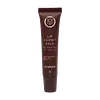What's inside
What's inside
 Key Ingredients
Key Ingredients

 Benefits
Benefits

 Concerns
Concerns

 Ingredients Side-by-side
Ingredients Side-by-side

Paraffinum Liquidum
EmollientMicrocrystalline Wax
Emulsion StabilisingSqualane
EmollientIsopropyl Myristate
EmollientSynthetic Beeswax
Emulsion StabilisingHydrogenated Styrene/Isoprene Copolymer
CI 15850
Cosmetic ColorantCI 45410
Cosmetic ColorantGlyceryl Caprylate
EmollientOzokerite
Emulsion StabilisingCeramide NP
Skin ConditioningOlea Europaea Fruit Oil
MaskingLimnanthes Alba Seed Oil
Skin ConditioningTocopheryl Acetate
AntioxidantParfum
MaskingLimonene
PerfumingParaffinum Liquidum
EmollientPolyisobutene
Bis-Diglyceryl Polyacyladipate-2
EmollientSqualane
EmollientTridecyl Trimellitate
EmollientCera Microcristallina
Emulsion StabilisingOzokerite
Emulsion StabilisingCaprylic/Capric Triglyceride
MaskingHydrogenated Styrene/Isoprene Copolymer
Glyceryl Caprylate
EmollientLimnanthes Alba Seed Oil
Skin ConditioningArgania Spinosa Kernel Oil
EmollientSodium Hyaluronate
HumectantHydrogenated Castor Oil
EmollientIsopropyl Titanium Triisostearate
EmollientParaffinum Liquidum, Polyisobutene, Bis-Diglyceryl Polyacyladipate-2, Squalane, Tridecyl Trimellitate, Cera Microcristallina, Ozokerite, Caprylic/Capric Triglyceride, Hydrogenated Styrene/Isoprene Copolymer, Glyceryl Caprylate, Limnanthes Alba Seed Oil, Argania Spinosa Kernel Oil, Sodium Hyaluronate, Hydrogenated Castor Oil, Isopropyl Titanium Triisostearate
Ingredients Explained
These ingredients are found in both products.
Ingredients higher up in an ingredient list are typically present in a larger amount.
Glyceryl Caprylate comes from glycerin and caprylic acid, a fatty acid from coconut. It has emollient and emulsifier properties.
As an emollient, it helps hydrate your skin. Emollients work by creating a barrier on your skin to trap moisture in, helping to keep your skin soft and smooth.
On the other hand, emulsifiers prevent ingredients (such as oil and water) from separating.
Learn more about Glyceryl CaprylateWe don't have a description for Hydrogenated Styrene/Isoprene Copolymer yet.
Limnanthes Alba Seed Oil is the oil extracted from the seeds of the meadowfoam plant. This oil is non-fragrant and is an emollient. As an emollient, meadowfoam seed oil helps soften and hydrate the skin.
Meadowfoam seed oil is stable and has a long shelf life due to its chemical structure. It has the highest concentration of stable fatty-acids among plant oils, preventing it from degrading once exposed to oxygen.
Due to the fatty acid content, this ingredient may not be fungal-acne safe.
Meadowfoam is native to California and Oregon.
Learn more about Limnanthes Alba Seed OilOzokerite is a naturally occuring mineral wax. In cosmetics, ozokerite is used as a texture enhancer.
Ceresin wax is derived from this ingredient.
The melting point of ozokerite is 58-100 C.
Ozokerite is found all over the world including Scotland, the US, and India.
Learn more about OzokeriteParaffinum Liquidum is also known as liquid paraffin. It is a type of highly refined mineral oil.
Like other oils, Paraffinum Liquidum has emollient properties. Emollients help soothe and soften the skin. By creating a barrier to trap moisture within, emollients help keep your skin hydrated.
Paraffinum Liquidum does not irritate the skin and is non-comedogenic.
Learn more about Paraffinum LiquidumSqualane is an emollient that helps the skin hold onto moisture. It's an oily liquid that occurs naturally in certain types of fish and plant oils.
Because squalane boosts hydration in the skin, it also comes with plenty of benefits: it is an antioxidant and can help fight free radicals and skin damage. Squalane is also found to have a detoxifying effect when applied.
Squalane comes from squalene, which occurs naturally within the sebum of our skin. It is one of the oils our skin produces to keep itself hydrated. Squalane is the hydrogenated version of squalene and has a longer shelf life.
Research shows that squalane is non-irritating (even at 100% concentration).
In general, it's a fantastic ingredient. It does a great job at hydrating the skin, and it's suitable for those with sensitive skin.
The source of squalane may impact malassezia / fungal acne. This is because olive oil derived squalane can contain impurities such as fatty acids and plant waxes. Sugarcane derived squalane is recommended for anyone with malassezia concerns.
Is squalane vegan?
This depends on the source. Squalane can be derived from both plants and animals. Most squalane used in skincare comes from plants.
Please note: the source of squalane is only known if disclosed by the brand. We recommend reaching out to the brand if you have any questions about their squalane.
Read more about squalene with an "e".
Is squalane an oil?
Squalane is often called an oil, but it’s technically not; it’s a hydrocarbon, meaning it’s only made of carbon and hydrogen, unlike true oils which are triglycerides made of fatty acids and glycerol.
The term “oil-free” isn’t regulated, so companies can define it however they want. Some exclude all oils, while others just avoid mineral oil or comedogenic oils.
While some people avoid oils thinking they cause breakouts, the right kind of oil (or oil-like ingredient like squalane) can actually help balance and hydrate your skin. It’s worth testing out simple oils or squalane to see what works best for your skin.
Learn more about Squalane